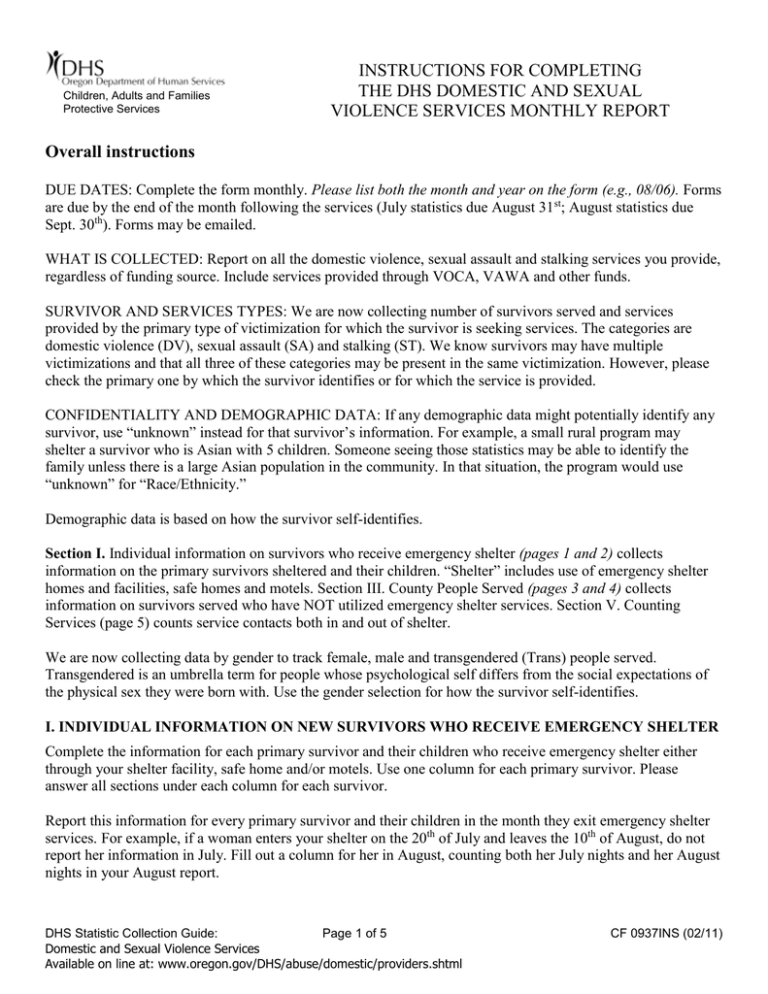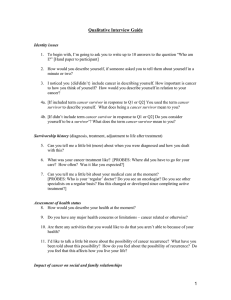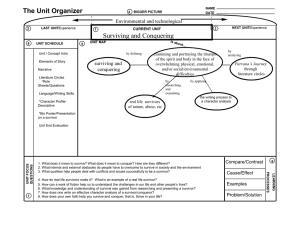
Children, Adults and Families
Protective Services
INSTRUCTIONS FOR COMPLETING
THE DHS DOMESTIC AND SEXUAL
VIOLENCE SERVICES MONTHLY REPORT
Overall instructions
DUE DATES: Complete the form monthly. Please list both the month and year on the form (e.g., 08/06). Forms
are due by the end of the month following the services (July statistics due August 31st; August statistics due
Sept. 30th). Forms may be emailed.
WHAT IS COLLECTED: Report on all the domestic violence, sexual assault and stalking services you provide,
regardless of funding source. Include services provided through VOCA, VAWA and other funds.
SURVIVOR AND SERVICES TYPES: We are now collecting number of survivors served and services
provided by the primary type of victimization for which the survivor is seeking services. The categories are
domestic violence (DV), sexual assault (SA) and stalking (ST). We know survivors may have multiple
victimizations and that all three of these categories may be present in the same victimization. However, please
check the primary one by which the survivor identifies or for which the service is provided.
CONFIDENTIALITY AND DEMOGRAPHIC DATA: If any demographic data might potentially identify any
survivor, use “unknown” instead for that survivor’s information. For example, a small rural program may
shelter a survivor who is Asian with 5 children. Someone seeing those statistics may be able to identify the
family unless there is a large Asian population in the community. In that situation, the program would use
“unknown” for “Race/Ethnicity.”
Demographic data is based on how the survivor self-identifies.
Section I. Individual information on survivors who receive emergency shelter (pages 1 and 2) collects
information on the primary survivors sheltered and their children. “Shelter” includes use of emergency shelter
homes and facilities, safe homes and motels. Section III. County People Served (pages 3 and 4) collects
information on survivors served who have NOT utilized emergency shelter services. Section V. Counting
Services (page 5) counts service contacts both in and out of shelter.
We are now collecting data by gender to track female, male and transgendered (Trans) people served.
Transgendered is an umbrella term for people whose psychological self differs from the social expectations of
the physical sex they were born with. Use the gender selection for how the survivor self-identifies.
I. INDIVIDUAL INFORMATION ON NEW SURVIVORS WHO RECEIVE EMERGENCY SHELTER
Complete the information for each primary survivor and their children who receive emergency shelter either
through your shelter facility, safe home and/or motels. Use one column for each primary survivor. Please
answer all sections under each column for each survivor.
Report this information for every primary survivor and their children in the month they exit emergency shelter
services. For example, if a woman enters your shelter on the 20th of July and leaves the 10th of August, do not
report her information in July. Fill out a column for her in August, counting both her July nights and her August
nights in your August report.
DHS Statistic Collection Guide:
Page 1 of 5
Domestic and Sexual Violence Services
Available on line at: www.oregon.gov/DHS/abuse/domestic/providers.shtml
CF 0937INS (02/11)
Type of abuse
Select “DV”, “SA” or “ST” based on the primary issue the survivor identified as leading to the need for shelter.
Gender
Select the gender selection which the survivor self-identifies.
Adult race/ethnicity background
Check as many choices as identified by the survivor.
Abuser is
Check only one category to identify the abuser’s relationship to the survivor.
Spouse (current or ex) refers to an intimate partner relationship where the survivor is/was legally
married to the abuser.
Child means that the child of the survivor is the abusive party.
Dating partner refers to an intimate partner relationship in which the survivor and the abuser have
never lived together.
Co-habitant (current or ex) refers to someone who is/was in an intimate partner relationship with the
survivor and lived together. If the abuser is/was a room-mate and not in an intimate partner relationship
with the survivor, code under “Other”.
Parent means that the parent of the survivor is the abusive party.
If a survivor has multiple abusers (for example, spouse and in-laws), count the primary abuser only.
Primary survivor identifies as having a disability
Check if the survivor self-identifies as having a physical, mental or medical disability. If unknown, leave blank.
Primary survivor’s primary language not English
Check if the adult identifies as having a primary language other than English.
Total primary survivor nights
Count the total number of shelter nights provided when the survivor leaves emergency shelter. For example, if a
woman enters shelter on July 20th and leaves August 10th, count both her July nights and August nights on
your August report. If a survivor is housed in a motel for 3 nights then comes into shelter for 10 nights, count
her for one stay with 13 nights.
Primary survivor participated in safety planning
We are counting those primary survivors who have participated in safety planning as part of reporting for DOJ’s
Oregon Domestic & Sexual Violence Services Fund. Check if you discussed safety planning with the survivor.
The plan does not need to be written, but at least discussed.
Children
Only count the primary survivor’s children who received shelter. Count them if they were there for part or all of
the stay. Children are divided into three age groups:
birth to age 5,
age 6 to 12 years, and
age 13 through 17 years.
DHS Statistic Collection Guide:
Page 2 of 5
Domestic and Sexual Violence Services
Available on line at: www.oregon.gov/DHS/abuse/domestic/providers.shtml
CF 0937INS (02/11)
Children’s race/ethnicity
Count the total number races and/or ethnicities self-identified for all the survivor’s children. If a woman has 3
children with 2 children identifying as “White” and one child identifying as both “Asian” and “White”, you
would count “3” under “White” and “1” under “Asian.”
Total child nights
Add the total child nights for that family and list that number. If a mother stays 10 nights and has 2 children
with her the whole time, count the child nights as 20. If one of the children was only there for 5 nights and the
other stayed the whole 10 nights, it would be counted as 15.
Child safety plans
Count the number of children who participated in safety planning.
II. COUNTING INCOMING CALLS
DV, SA or ST Calls: count all calls received on any agency line that related to an individual or family in need
of some kind of service. Count all calls including repeat callers and calls from third parties. “Substantive”
emails may be counted as calls. Use “DV”, “SA” or “ST” based on the primary issue identified. Do not count
calls for general information about program or violence issues unrelated to a specific family or individual. Do
not count calls about donations, calls from the media or other business calls.
Other issue calls: count all service related calls on other issues such as suicide, homelessness, etc.
III. COUNTING NON-SHELTER PEOPLE SERVED
A. All non-shelter survivors served this month
Count the unduplicated number of survivors who received IN-PERSON, NON-SHELTER SERVICES. Only
count each survivor once, even if you provided multiple services. Do not count current shelter residents.
Count Teens as “Primary” if they are seeking service for their own intimate partner violence under “DV” or if
they are seeking services for their own sexual assault under “SA.” Count them as secondary victims if they are
seeking services because of their parents’ victimization.
Teens are age 13 to 17. Children are age 12 and under.
Safety planning:
Of the non-shelter survivors counted above, count each survivor with whom you safety planned during the
month. The safety plan does not need to be written, but at least discussed. Only count a survivor once, no
matter how many times safety planning was provided.
B. Only brand new non-shelter survivors served.
Of those survivors counted in “A”, count the number served during the month with in-person, non-shelter
services who have NOT been previously counted in monthly statistics during the Federal Fiscal Year
(October through September.) These are survivors who are new to your agency this year. Do not include
current or previous shelter residents.
Teens are age 13 to 17; Children are age 12 and under.
Count Teens as “Primary” if they are seeking service for their own intimate partner violence under “DV”
or if they are seeking services for their own sexual assault under “SA.” Count them as secondary victims if
they are seeking services because of their parents’ victimization.
DHS Statistic Collection Guide:
Page 3 of 5
Domestic and Sexual Violence Services
Available on line at: www.oregon.gov/DHS/abuse/domestic/providers.shtml
CF 0937INS (02/11)
For Gender and Age, only COUNT A SURVIVOR ONCE, regardless of the number of times you provided
services. Under Race/Ethnicity, count all the races or ethnicities identified by each survivor.
For each demographic category, count how the survivor self-identifies. Use
“unknown/not specified” if the survivor does not want to give that information.
Safety planning
Of the brand new non-shelter survivors counted above in section B, count each survivor with whom you
safety planned during the month. The safety plan does not need to be written, but at least discussed. Only
count a survivor once, no matter how many times safety planning was provided.
C. Unduplicated number of primary survivors receiving co-case management
This category is for culturally specific providers to document how they partner with the
“mainstream” shelter programs to provide specialized and/or culturally specific services, especially
to traditionally underserved populations.
Count the UNDUPLICATED number of adult survivors with whom staff or volunteers had In-Person,
FACE-TO-FACE contact with while they resided at another domestic violence shelter. Only count each
person once per month.
D. Unable to shelter
Count the number of requests for shelter for adult survivors of domestic violence that were unable to be met
because the program was at capacity. Count each survivor even though you may shelter them at a later date.
Do not count individuals who were not served because their needs were inappropriate for your program
services (ex. non-domestic violence related homelessness.)
E. Total number of primary survivors sheltered
Count the total number of adults sheltered during the month. This number may be different from the first
page, as there may be victims being sheltered who stay over into the next month and therefore are not listed
on the first page.
IV. COUNTING VOLUNTEER HOURS
Count the total number of volunteer HOURS, including both direct service and other types of volunteer hours,
including hours volunteered by Board members.
V. COUNTING SERVICES
For each interaction with a survivor, identify and only count ONE primary service provided during that
interaction.
Count both in-shelter and non-shelter services. If during one month a survivor receives legal/court advocacy
once, attends four support groups, and meets with an advocate twice for information and referral services, count
her once for legal/court advocacy, four times for support groups and twice for I&R. Count service contacts
specifically for adults (18 and over), teens (13 to 17), and children (12 and under).
Identify service contacts by the primary type of victimization for which the survivor sought that service. The
categories are domestic violence (DV), sexual assault (SA) and stalking (ST). We know survivors may have
multiple victimizations and that all three of these categories may be present in the same victimization. However,
please check the primary one for which the service is provided.
DHS Statistic Collection Guide:
Page 4 of 5
Domestic and Sexual Violence Services
Available on line at: www.oregon.gov/DHS/abuse/domestic/providers.shtml
CF 0937INS (02/11)
The following are the service definitions:
A. Crisis Response/Counseling refers to in-person crisis intervention, emotional support, and guidance and
counseling on an individual basis provided by advocates, counselors, mental health professionals or
peers. Such counseling may occur: a) at the scene of a crime; b) immediately after a crime; c) at the first,
in-person contact between an advocate/counselor and victim (this would include meeting a victim in an
emergency room, at a police station, or at a district attorney’s office, etc.); d) during in-person contact for
the duration of the crisis experience; or e) may occur months after the victimization.
B. Support Group refers to the coordination and provision of supportive group activities. This includes selfhelp, peer, social support, and drop-in groups which validate the experiences of survivors, do not blame
them for the abuser’s behavior, explore options, build on strengths, and respect the survivor’s right to
make their own decisions.
C. In-Person Information and Referral refers to identifying services needed, and offering support and
referrals to other community agencies.
D. Phone Information and Referral refers to identifying services needed, and offering support and referrals
to other community agencies. “Substantive” emails may be counted as calls.
E.
Follow-up Services refers to individual emotional support, empathetic listening, and guidance outside of
the initial crisis response. It may be in-person or by phone.
F.
Accompaniment to Medical refers to going with or meeting a survivor at a hospital or medical center to
provide advocacy and support. This includes providing support during a SAFE exam.
G. Legal/court Advocacy refers to assisting a survivor with the court process including accompanying to
court or working with the victim’s assistance office
H. Other Advocacy: assisting survivors in obtaining other needed services when they are unable to represent
themselves effectively. It may be in-person or by phone.
I.
Child/Dependent Care: care provided to dependents of adult victims while the adult survivor is receiving
services and/or respite care. Examples include baby-sitting during support groups or staying with a
dependent adult while the survivor goes to court.
VI. SPEAKING ENGAGEMENTS
Count presentations as domestic violence, sexual assault, stalking or all three based on the topic of
the presentation.
Count the number of adults, teens and children present at those presentations.
Of the presentations counted above, count the ones that are school-based and the number of children and teens
present for those. We use this data in our Federal FVPSA report when talking about prevention activities.
VII. PUBLIC AWARENESS
Count the number of events where an exact count of the audience members cannot be obtained (press
conferences, booths at health fairs, radio shows, etc.)
DHS Statistic Collection Guide:
Page 5 of 5
Domestic and Sexual Violence Services
Available on line at: www.oregon.gov/DHS/abuse/domestic/providers.shtml
CF 0937INS (02/11)





